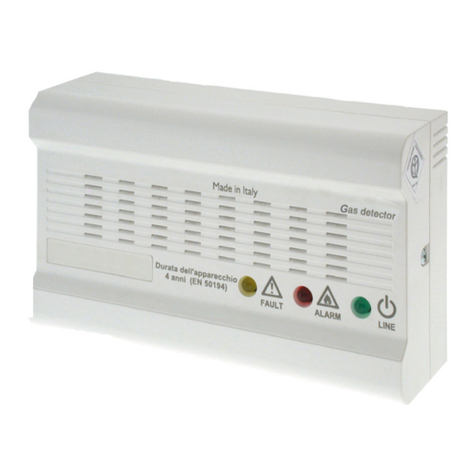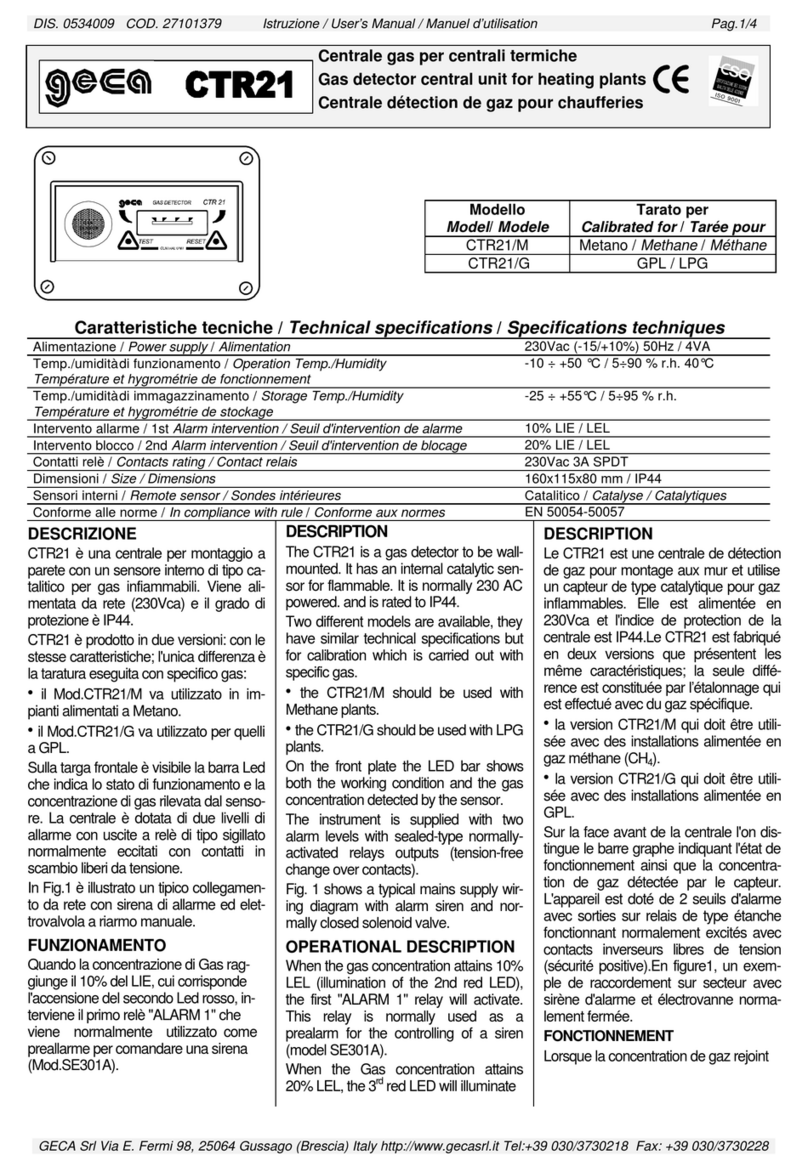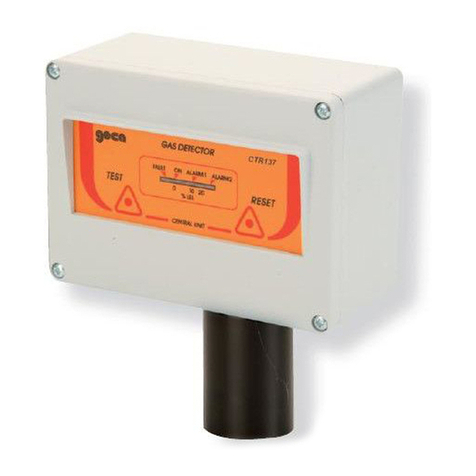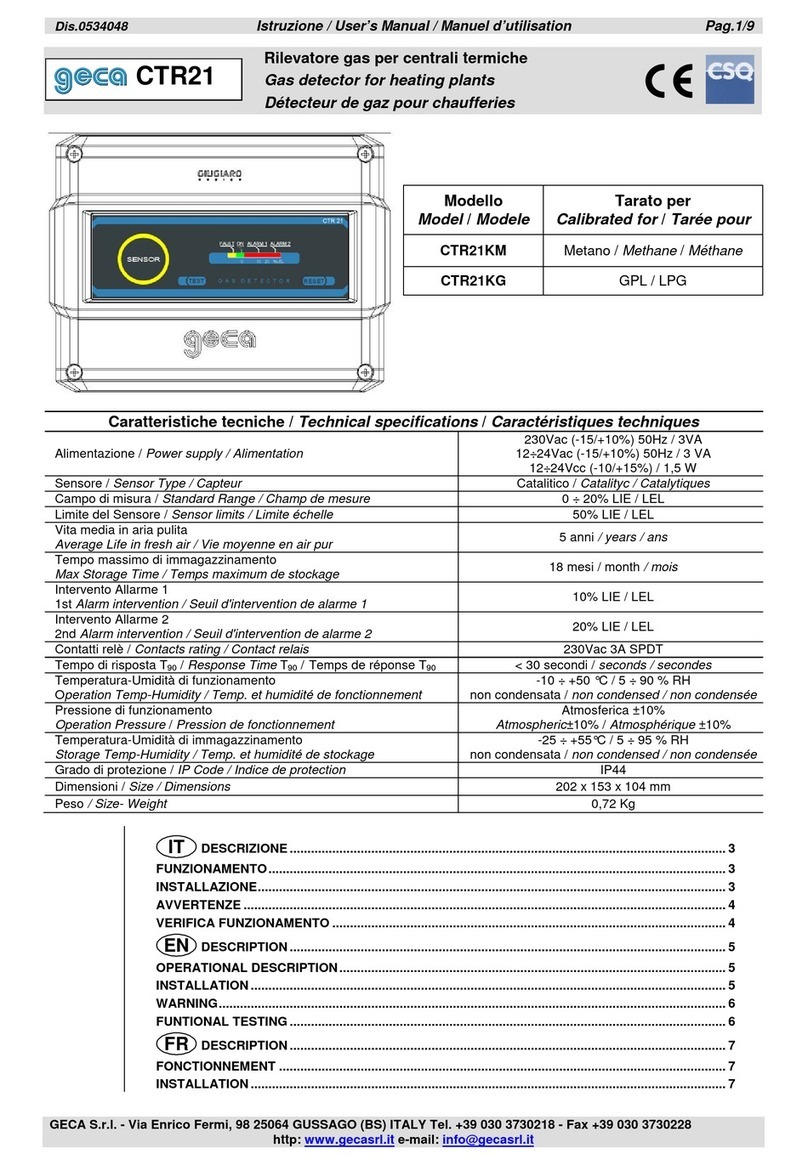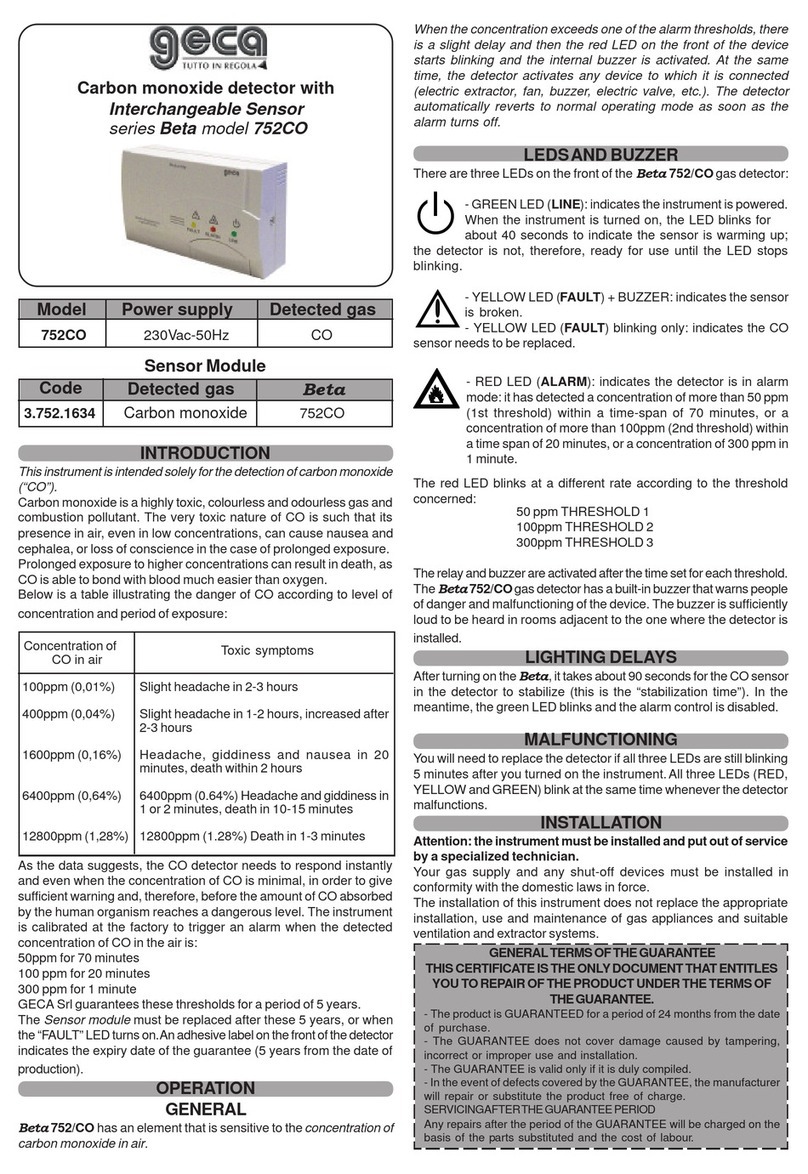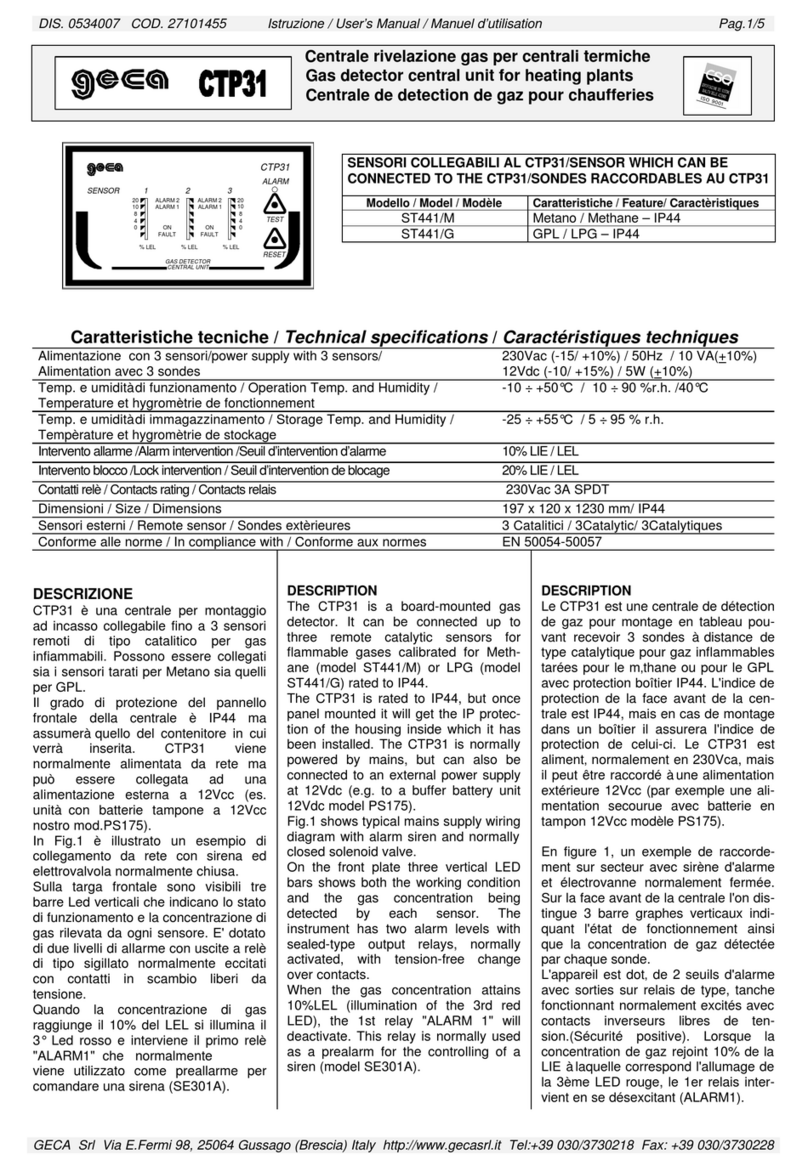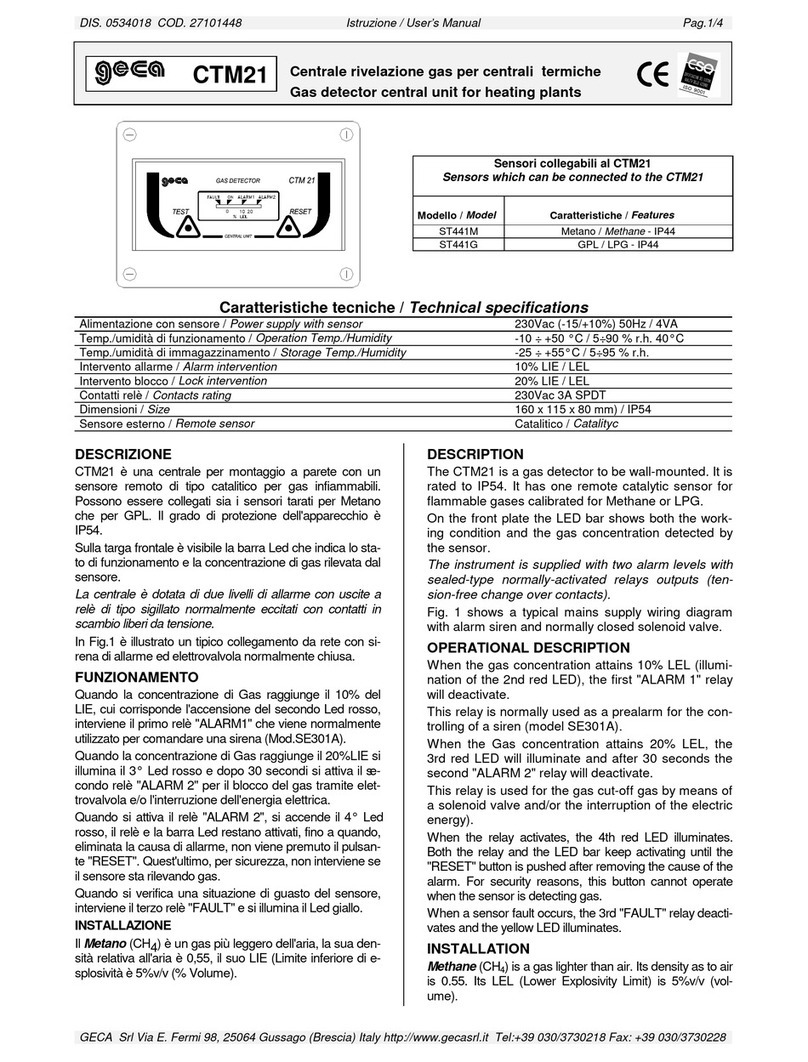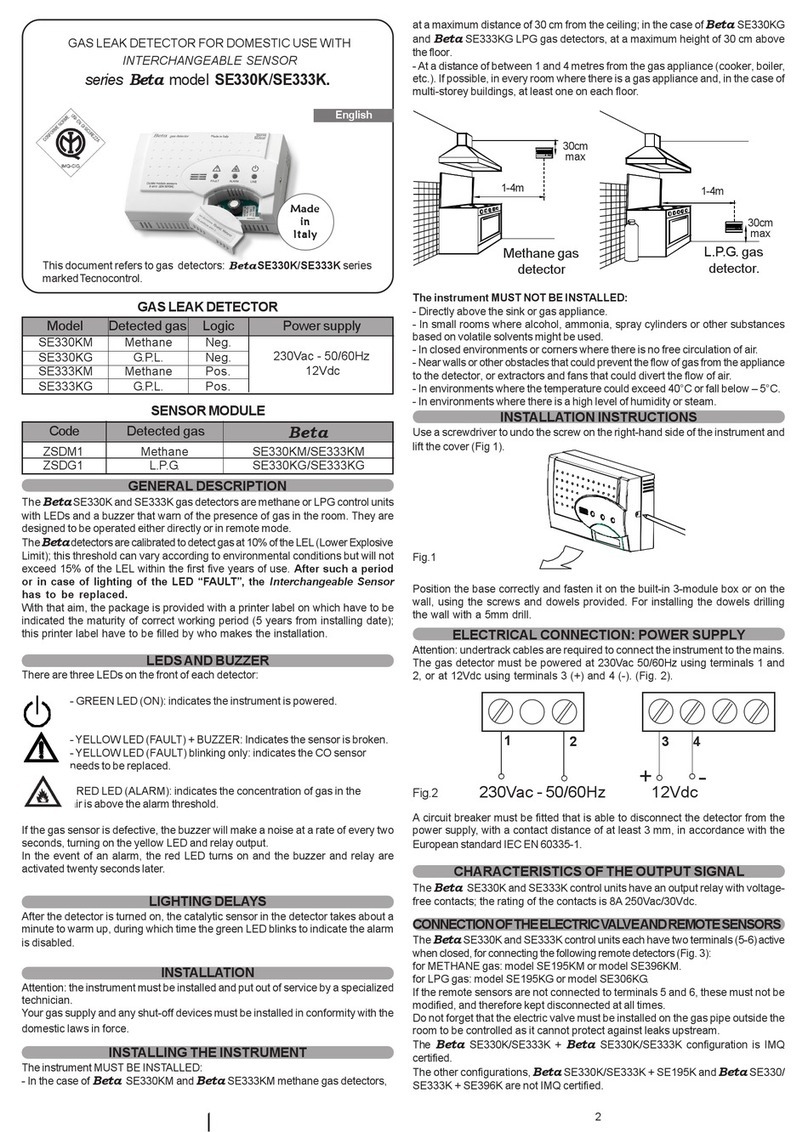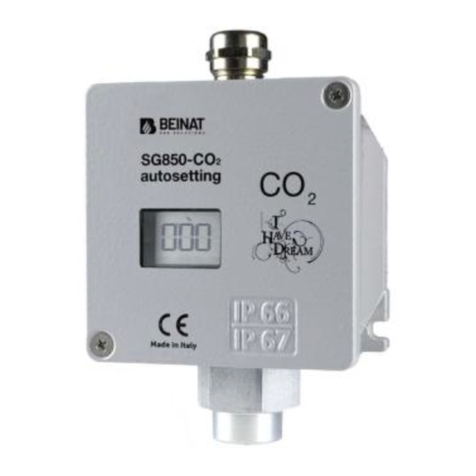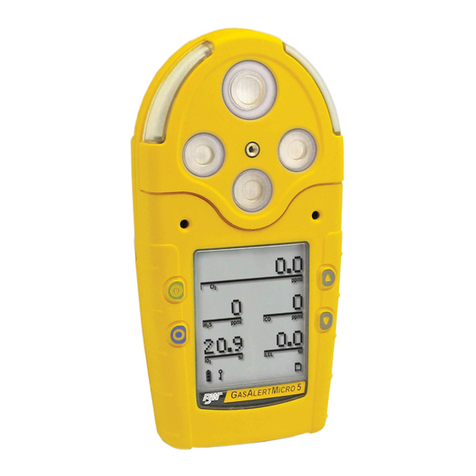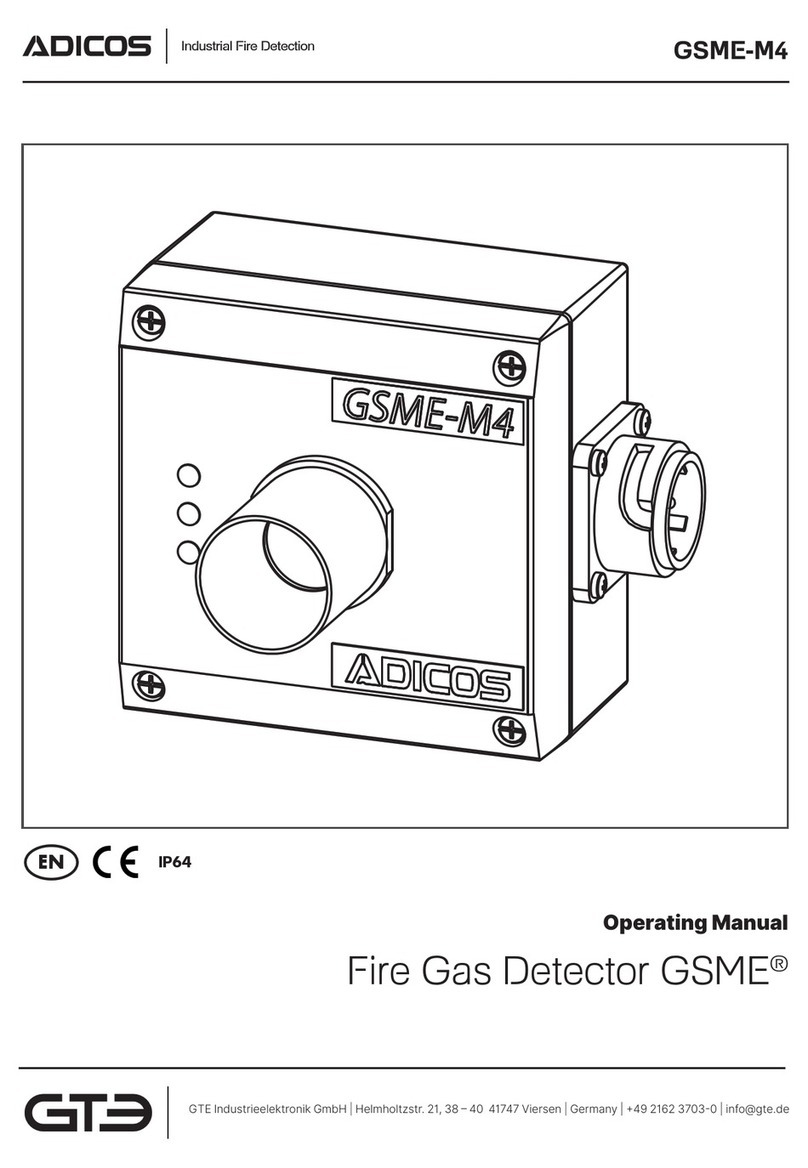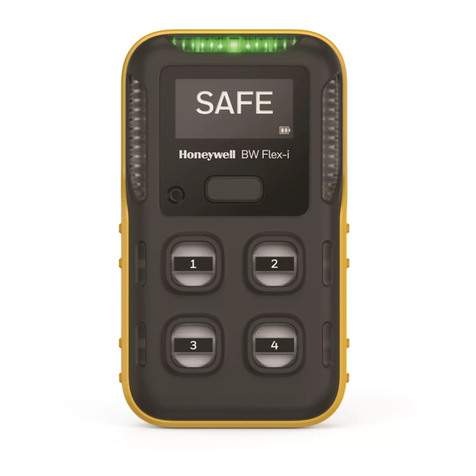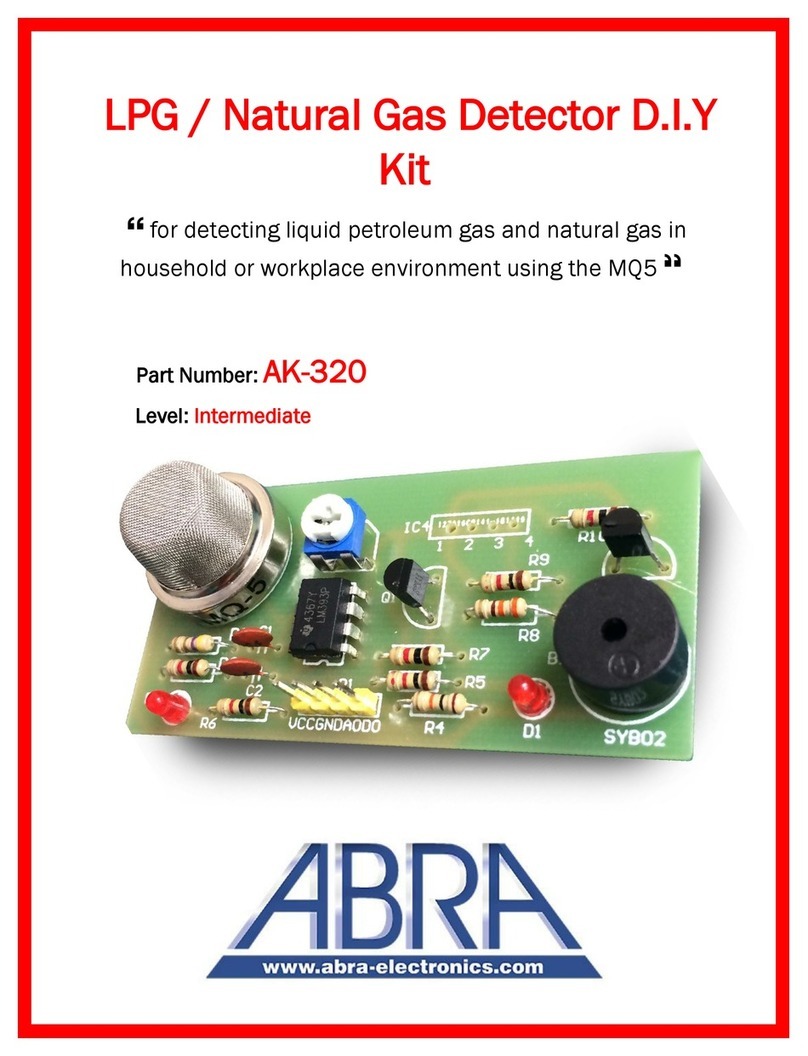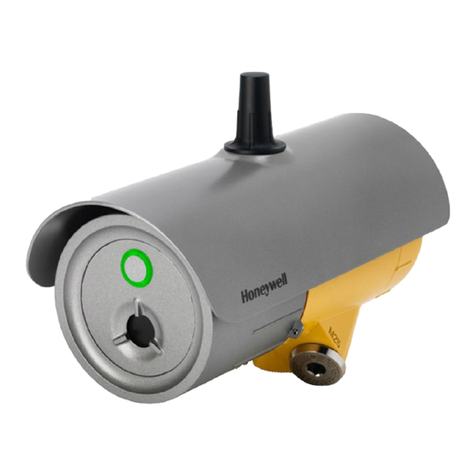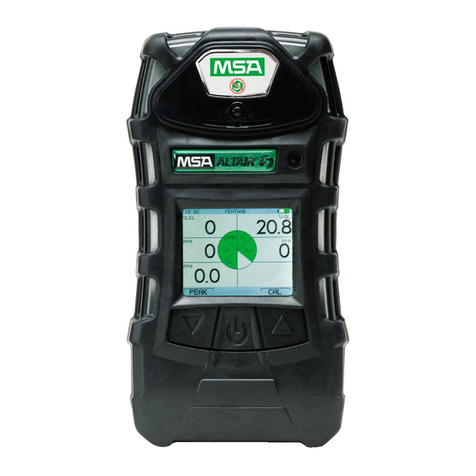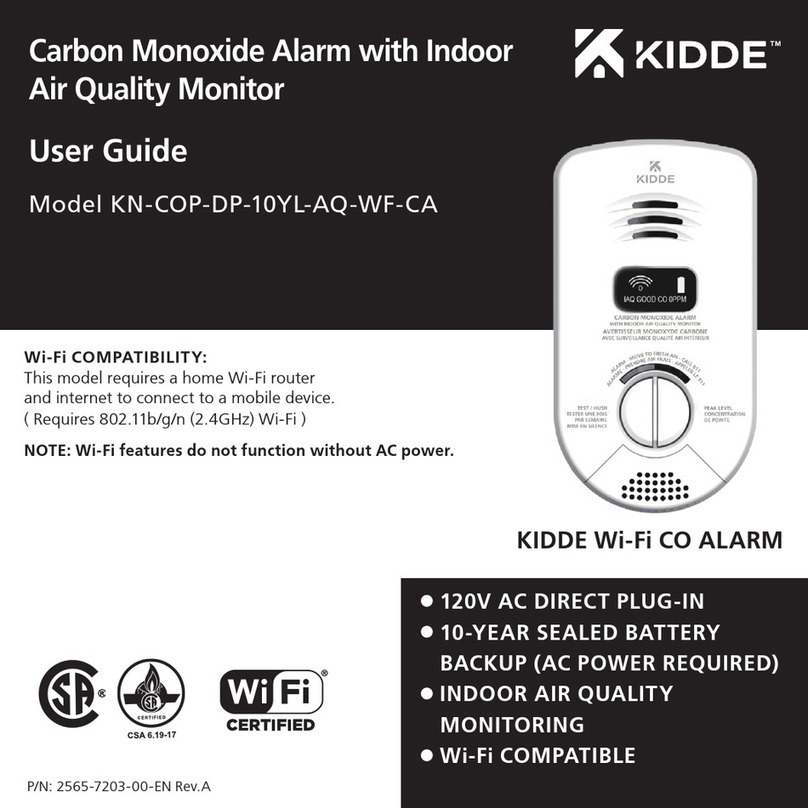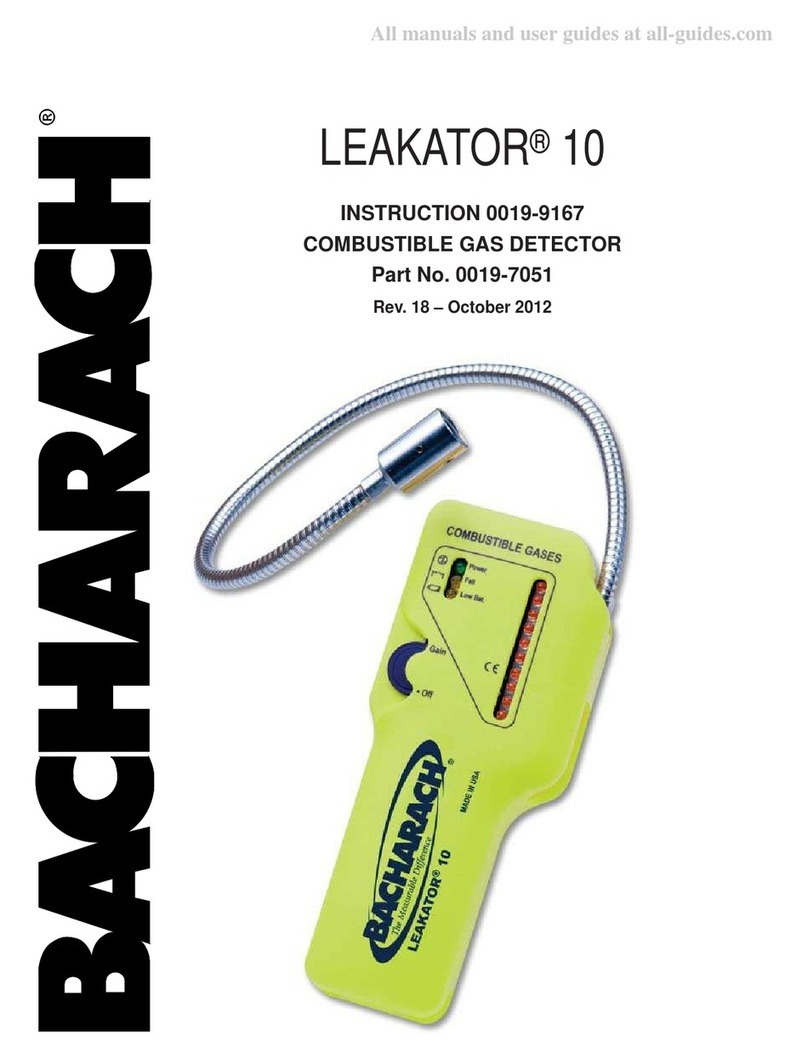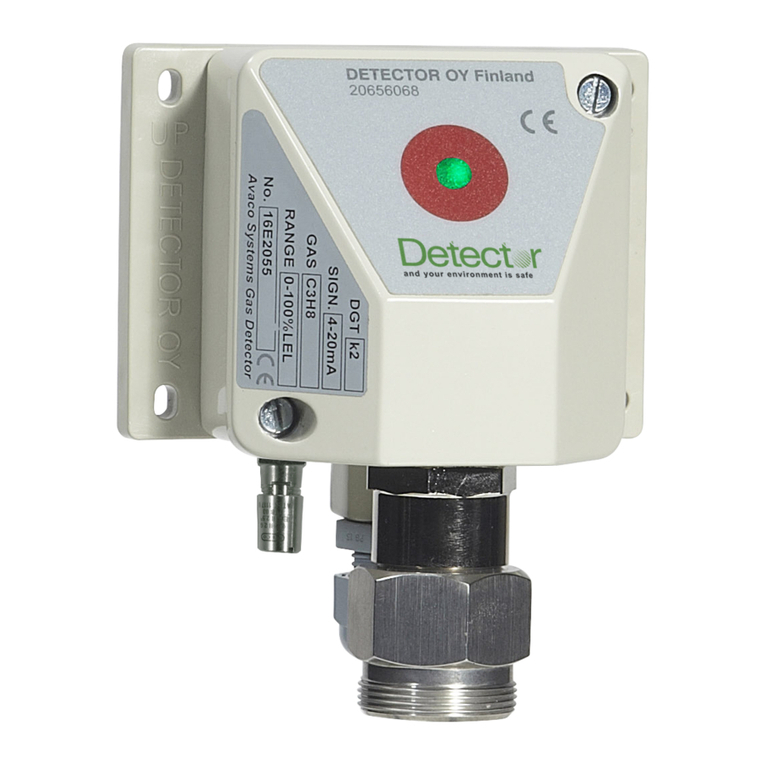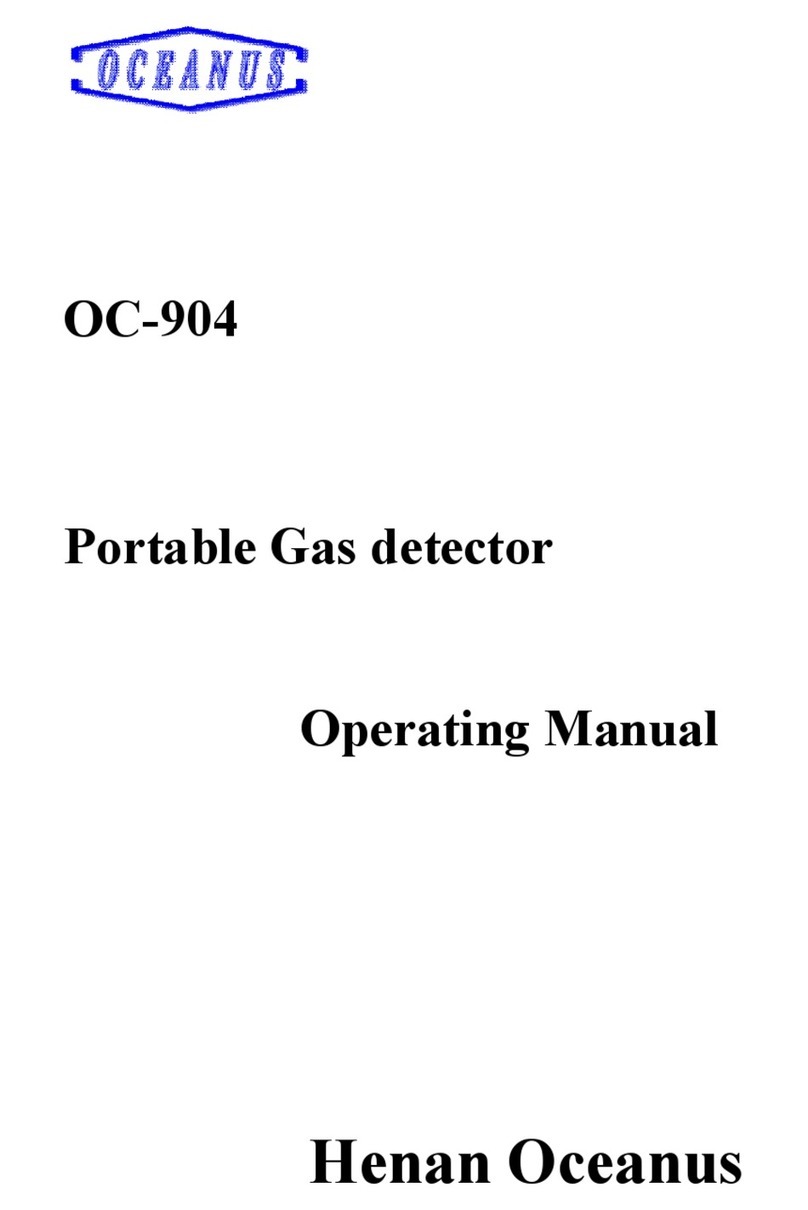Geca Tecnocontrol Beta Series User manual

Italiano
DESCRIZIONE GENERALE
Questo documento si riferisce ai rivelatori di gas serie Beta mod.SE330K-SE333K marcati Tecnocontrol.
SEGNALAZIONI LUMINOSE E ACUSTICHE
RITARDI ALL’ACCENSIONE
Il sensore catalitico presente nel rivelatore Beta ha bisogno di essere riscal-
dato per circa un minuto prima di funzionare correttamente, per questo motivo
all’accensione del rivelatore il led verde lampeggerà ad indicare che il sensore
è nella fase di riscaldamento.
Durante tale periodo le funzioni di rivelazione saranno inibite.
Modello
SE330KM
SE330KG
SE333KM
SE333KG
Gas rilevato
Metano
G.P.L.
Metano
G.P.L.
Logica
Negativa
Negativa
Positiva
Positiva
Alimentazione
230Vac - 50/60Hz
12Vdc
Questi rivelatori sono dotati, sulla parete frontale, di tre segnalazioni luminose:
- LED VERDE (ON): Indica che l’apparecchio è alimentato.
- LED GIALLO (FAULT): Indica che il sensore gas è guasto.
- LED GIALLO (FAULT) solo lampeggio:Indica che il sensore
gas è da sostituire.
- LED ROSSO (ALARM): Indica che la concentrazione di gas
misurata nell’aria è superiore alla soglia d’allarme.
Nel caso il sensore si guasti il rivelatore è in grado di segnalare il malfunziona-
mento attivando la suoneria con un intermittenza di due secondi, accendendo
in modo fisso il led giallo e l’uscita relè.
In caso di allarme, dalla centralina o da remoto, si accende il led rosso e dopo
venti secondi si aziona la suoneria ed il relè.
Attenzione: l’installazione e la messa fuori servizio dell’apparecchio devo-
no essere eseguiti da personale tecnico specializzato.
L’installazione di gas e l’eventuale dispositivo di arresto devono essere con-
formi alle prescrizioni di legge nazionali vigenti.
L’apparecchio DEVE ESSERE INSTALLATO:
- I rivelatori serie Beta mod. SE330KM/SE333KM per gas metano ad una
distanza massima di 30 cm dal soffitto; i rivelatori serie Beta mod.SE330KG/
SE333KG per gas G.P.L. ad un’altezza massima di 30 cm dal pavimento.
- Ad una distanza compresa tra 1 metro e 4 metri dall’utilizzatore a gas (cucina,
caldaia ecc.).
- Possibilmente in ogni locale in cui è presente un apparecchio a gas e nelle
abitazioni a più piani, almeno uno ogni piano.
L’apparecchio NON DEVE ESSERE INSTALLATO:
- Direttamente sopra il lavabo o l’apparecchio a gas.
- In locali piccoli dove possano essere utilizzati alcool, ammoniaca, bombolette
spray o altre sostanze a base di solventi volatili.
- In locali chiusi o angoli in cui non c’è una libera circolazione dell’aria.
- Vicino a pareti o altri ostacoli che possano ostruire il flusso del gas
dall’utilizzatore al rivelatore, o ad aspiratori e ventole che possano deviare il
flusso dell’aria.
- In ambienti dove la temperatura possa portarsi al di sopra di 40°C o al di sotto
di -10°C.
- In ambienti con forte umidità o vapori.
POSIZIONAMENTO DELL’APPARECCHIO
PROCEDURA PER L’INSTALLAZIONE
COLLEGAMENTO ELETTRICO
ALIMENTAZIONE
Attenzione: I collegamenti elettrici devono essere effettuati mediante cavi
sottotraccia.
I rivelatori gas SE330K/SE333K devono essere alimentati a 230Vac-50/60Hz
attraverso i morsetti 1 e 2, oppure a 12Vdc attraverso i morsetti 3 (+) e 4 (-)
come da Figura 2.
Fig.2
Deve essere previsto un dispositivo per la disconnessione del rivelatore dalla
rete di alimentazione, con apertura contatti di almeno 3mm secondo quanto de-
scritto dalla “Normativa Europea CEI EN 60335-1”.
I rivelatori gas serie Beta mod. SE330K e mod.SE333K sono centraline di gas
metano o G.P.L. che avvisano, per mezzo di un segnale ottico ed acustico, la
presenza di gas in ambiente. Essi sono progettati in modo tale da poter funzio-
nare sia da centralina che da rivelatore remoto.
I rivelatori della serie Beta sono tarati per rilevare una concentrazione di gas
pari al 10% del L.I.E.(Limite Inferiore di Esplosività), tale soglia potrà variare in
base alle condizioni ambientali ma non supererà durante i primi 5 anni di eserci-
zio il 15% del L.I.E. Dopo tale periodo o in caso di accensione del LED “FAULT”
il Modulo sensore dovrà essere sostituito.
A questo scopo sul coperchio è presente una dicitura sulla quale deve essere
indicata la scadenza del periodo di corretto funzionamento (5 anni dalla data di
installazione), tale dicitura dovrà essere compilata dall’installatore del rivelatore
al momento dell’installazione.
Con l’ausilio di un cacciavite svitare la vite
posta sul lato destro dell’apparecchio e sol-
levare il coperchio (Fig.1).
Posizionare in modo corretto la base e fis-
sarla sulla scatola ad incasso 3 moduli o sulla
parete utilizzando viti e tasselli in dotazione.
Per il fissaggio dei tasselli forare la parete
con una punta di diametro 5mm.
INSTALLAZIONE
CARATTERISTICHE DEL SEGNALE DI USCITA
I rivelatori serie Beta mod. SE330K e mod.SE333K sono provvisti di un relè in
uscita con i contatti liberi da tensione; portata contatti 8A 250Vac / 30Vdc.
CENTRALINA FUGHE DI GAS
Fig.1
COLLEGAMENTO ELETTROVALVOLA E REMOTO
Le centraline serie Beta mod.SE330K e mod. SE333K possiedono due mor-
setti (5-6), attivi in chiusura che servono per collegare i seguenti rivelatori re-
moti (Fig.3):
- per gas METANO: mod. SE396KM o mod. SE195KM.
- per gas GPL: mod. SE396KG o mod. SE195KG.
Se ai morsetti 5 e 6 non vengono collegati i remoti, questi devono rimanere
inalterati, cioè sempre scollegati.
Ricordiamo che l’elettrovalvola va installata sulla tubazione del gas all’esterno
del locale da controllare in quanto non può proteggere da perdite che avvenga-
no a monte della stessa.
12
Rivelatore gas Metano Rivelatore gas GPL
1-4 mt
30cm
max
1-4 mt
30cm
max
oppure
230Vac-50/60Hz
1 2
12Vdc
3 4
+ -
Modulo sensore
Codice
ZSDM1
ZSDG1
Gas rilevato
Metano
G.P.L.
Beta
SE330KM/SE333KM
SE330KG/SE333KG
Modello
SE396KM
SE396KG
Gas Rilevato
Metano
G.P.L.
Alimentazione
230Vac - 50/60Hz
12Vdc
RIVELATORE REMOTO FUGHE DI GAS
CENTRALINA E RIVELATORE REMOTO FUGHE DI GAS
PER USO DOMESTICO CON SENSORE INTERCAMBIABILE
serie Beta mod. SE330/333K per gas Metano o GPL
serie Beta mod. SE396K per gas Metano o GPL

La configurazione Beta SE330K/SE333K + (Beta SE330K/SE333K oSE396K)
è coperta dal marchio IMQ. Le altre configurazioni (es. Beta SE330K/SE333K
+ SE195K ) non sono coperte dal marchio IMQ tuttavia rispettano appieno la
normativa CEI UNI EN 50194-1:2009.
LOGICA NEGATIVA - LOGICA POSITIVA
LOGICA POSITIVA (SE333K)
In questo caso la bobina del relè è mantenuta cstantemente alimentata
(Fig.7) in modo da assicurare una sicurezza di tipo intrinseca sul funziona-
mento del relè.
Ideale per le elettrovalvole di tipo N.C. (Normalmente Chiusa, Fig.8).
In caso di allarme i contatti 7 e 8 rimarranno chiusi fino al cessato al-
larme.
Esempio di applicazione con elettrovalvola Normalmente Chiusa (N.C.)
Fig.8
ATTENZIONE: Se durante il funzionamento in LOGICA POSITIVA avviene
una momentanea assenza di tensione, la valvola N.C. si chiude automatica-
mente e si renderà necessario provvedere al riarmo manuale della valvola,
dopo il ripristino della tensione.
Gli schemi di seguito rappresentati mostrano il collegamento tra due rive-
latori con un’unica elettrovalvola. E’ possibile collegare anche più di due
rivelatori ripetendo i collegamenti qui riportati.
Collegamento con valvola a riarmo manuale Normalmente Chiusa a 230Vac (relè nor-
malmente eccitato) e un secondo rivelatore SE333K.
Collegamento con valvola a riarmo manuale Normalmente Chiusa a 12Vdc (relè nor-
malmente eccitato) e un secondo rivelatore SE333K.
Il rivelatore gas serie Beta mod. SE330K e mod. SE333K può comandare
un’elettrovalvola in due logiche diverse, grazie alla presenza del JUMPER J2,
che permette di selezionare quella desiderata.
- LOGICA NEGATIVA (SE330K)
- LOGICA POSITIVA (SE333K)
N.B. Di default il JUMPER 2 è impostato su LOGICA NEGATIVA (SE330K).
NA
7
C
8
NC
9
JUMPER J2
in posizione
LOGICA POSITIVA
SE330K SE396K
230Vac-50/60Hz
Elettrovalvola gas
Normalmente Aperta
a riarmo manuale
230Vac-50/60Hz
Fig.4
NC
7
C
8
NA
9
JUMPER J2
in posizione
LOGICA NEGATIVA
230Vac-50/60Hz
Elettrovalvola gas
Normalmente Chiusa
a riarmo manuale
SE330K
SE330K
12Vdc
Elettrovalvola
Normalmente
Aperta 12Vdc
SE330K
SE330K
230Vac-50/60Hz
Elettrovalvola
Normalmente
Aperta 230Vac-50/60Hz
SE330K
Fig.7
230Vac-50/60Hz
Elettrovalvola gas
Normalmente Chiusa
a riarmo manuale
SE333K
230Vac-50/60Hz
Elettrovalvola gas
Normalmente Chiusa
a riarmo manuale
SE333K SE333K
230Vac-50/60Hz
Elettrovalvola gas
Normalmente Chiusa
a riarmo manuale
SE333K SE333K
12Vdc
12Vdc
Per la serie Beta, mod. SE330K eSE333K prima della prova di funzionamen-
to, occorre aprire il coperchietto posto al di sotto dei tre LED di segnalazione
(Fig.9) tramite un cacciavite piatto.
Fig.9
Terminata l’operazione è possibile controllare il corretto funzionamento
dell’apparecchio tenendo premuto per almeno 2 secondi il tastino TEST po-
sizionato sul Modulo sensore (Fig.10) della centralina serie Beta mod.
SE330K eSE333K, o per 30 secondi quello sulla scheda del rivelatore remoto
serie Beta mod. SE396K se collegato.
In questo modo si accenderanno tutti i led, si attiverà la suoneria e l’uscita relè
per un periodo di cinque secondi.
Fig.10
Sarà dunque necessario riarmare l’eventuale elettrovalvola collegata all’uscita
del rivelatore di gas.
CONTROLLO FUNZIONAMENTO
LOGICA NEGATIVA (SE330K)
In questo caso la bobina del relè è mantenuta costantemente diseccitata
(Fig.4) . Ideale per le elettrovalvole tipo N.A. (normalmente aperta, Fig.5) o
N.C. (normalmente chiusa, Fig. 6).
In caso di allarme i contatti 8 e 9 rimarranno chiusi fino al cessato al-
larme.
Esempio di applicazione con elettrovalvola Normalmente Aperta (N.A.)
Fig.5
Esempio di applicazione con elettrovalvola Normalmente Chiusa (N.C.)
Fig.6
Gli schemi di seguito rappresentati mostrano il collegamento tra due rivelatori con
un’unica elettrovalvola.
E’ possibile collegare anche più di due rivelatori ripetendo i collegamenti qui riportati.
Collegamento con valvola a riarmo manuale Normalmente Aperta a 230Vac (relè nor-
malmente diseccitato) e un secondo rivelatore SE330K.
Collegamento con valvola a riarmo manuale Normalmente Aperta a 12Vdc (relè nor-
malmente diseccitato) e un secondo rivelatore SE330K.
230Vac-50/60Hz
Elettrovalvola gas
Normalmente Aperta
a riarmo manuale
SE330K
3 4

L’uso di sistemi diversi dalla bombola di taratura con gas campione, rende im-
possibile l’accertamento del corretto funzionamento del sensore.
Anche quando si volessero ricreare le effettive condizioni di pericolo a tutela del
quale è installato il sensore di gas, è inapplicabile per esempio, l’erogazione di
gas dai normali apparecchi di un ambiente domestico.
I nostri rivelatori sono tarati al 10% del L.I.E.(Limite inferiore di esplosività).
La spiegazione è semplice: supponiamo di avere una cucina dalle misure di 3
metri di larghezza per 4 metri di lunghezza, ed un’altezza di 3 metri.
- Il volume della cucina è equivalente a 4 x 3 x 3 cioè 36m3 pari a 36.000 Lt.
Quando il 4,4% del volume della cucina, viene accupato da Metano, nella stan-
za si crea una miscela pericolosa.
- Questo 4,4% vieni chiamato L.I.E. (Limite inferiore di esplosività).
- Nel nostro caso il 4,4% di 36.000Lt corrisponde a 1584Lt.(L.I.E.).
- I nostri rivelatori, per effetto della certificazione IMQ intervengono al 10% del
L.I.E., quindi al 10% del valore di 1584Lt che in questo caso corrisponde a
158,4Lt, QUINDI ALLA DECIMA PARTE DEL LIMITE INFERIORE DI ESPLO-
SIVITA’ (L.I.E.).
Tenendo conto del fatto che un fornello di casa ha un ugello di pochi decimi di
millimetro e che la pressione è di pochi millibar, se ne deduce che la portata di
gas permetterebbe l’erogazione di 158,4 litri di metano (quanto basta per fare
intervenire il sensore) soltanto dopo ore di tempo.
Anche utilizzando fonti di erogazione con portata più ampia, la particolare
e fortissima odorizzazione del metano però rende impossibile la permanen-
za dell’uomo e comunque trasmette la certezza di essere in grave pericolo
quando anche il metano in ambiente è ancora troppo poco per consentire
l’esplosione.
LIMITE INFERIORE DI ESPLOSIVITA’ (L.I.E.)
Si consiglia di far eseguire dal proprio installatore una verifica del funziona-
mento del rivelatore almeno una volta l’anno.
IMPORTANTE: Non utilizzare gas puro direttamente sul sensore, come ad
esempio il gas dell’accendino, in quanto il sensore ne risulterebbe dan-
neggiato in modo irreparabile.
VERIFICHE PERIODICHE
N.B. La sostituzione del Modulo sensore deve essere eseguita da person-
ale tecnico specializzato.
Il modulo sensore va sostituito per un massimo di DUE volte per una
durata totale di 15 anni di funzionamento del prodotto.
Al lampeggio del LED “FAULT” o trascorsi i 5 anni di utilizzo, sostituire il
modulo sensore.
Sostituire l’etichetta posta sul coperchio sulla quale deve essere indicata
la scadenza del periodo di corretto funzionamento (5 anni dalla data di in-
stallazione del nuovo modulo sensore), tale etichetta dovrà essere compilata
dall’installatore del rivelatore al momento della sostituzione del modulo sen-
sore.
SOSTITUZIONE SENSORE
MODULO SENSORE
Codice
ZSDM1
ZSDG1
Gas rilevato
Metano
G.P.L.
Beta
SE330KM/SE333KM
SE330KG/SE333KG
N.B. Assicurarsi che il codice del Modulo sensore nuovo corrisponda al
codice del Modulo sensore da sostituire.
1• Spegnere il rivelatore scollegan-
dolo dalla rete di alimentazione e
con l’aiuto di un cacciavite fare leva
nell’apposita fessura per rimuovere il
coperchietto posto sotto i tre LED.
Fig.11
2• Svitare le due viti di fissaggio
del Modulo sensore da sostituire
(Fig.12).
Fig.12
3• Estrarre il Modulo sensore da
sostituire (Fig.13).
Fig.13
4• Verificare che il Modulo sensore
nuovo sia compatibile con quello da
sostituire (in caso di modulo sensore
errato si accenderà il LED GIALLO ed
suonerà il BUZZER) e con la dovuta
cautela inserire i 4 connettori nella
sede appropriata.
Fig.14
5• Fissare il Modulo sensore tramite
le due viti e chiudere il coperchietto
inserendo prima i due perni inferiori.
(Fig.15).
Successivamente ripristinare la ten-
sione di alimentazione.
Fig.15
ll sensore catalitico presente nel rivelatore ha bisogno di essere riscaldato
per circa un minuto prima di funzionare correttamente, per questo motivo
all’accensione del rivelatore il led verde lampeggerà ad indicare che il sensore
è nella fase di riscaldamento.
Durante tale periodo le funzioni di rivelazione saranno inibite.
Per la pulizia dell’apparecchio utilizzare un panno per togliere la pol-vere po-
satasi sull’involucro.
Non tentare di aprire o smontare il rivelatore di gas, tale operazione può
causare scossa elettrica oltre a danneggiare il prodotto.
Tenere presente che il sensore ha una buona resistenza a prodottid’uso
comune quali spray, detersivi, alcool, colle o vernici. Questi prodotti posso-
no contenere sostanze che, in quantità elevate, interferiscono con il sensore
provocando falsi allarmi. Si consiglia di ventilare il locale quando si utilizzano
questi prodotti. Si rammenta che il rivelatore non è in grado di rilevare perdite
cheavvengano fuori dal locale in cui è installato oppure all’interno dei muri o
sotto al pavimento.
Il gas (Metano o GPL), è addizionato con un odorizzante particolarmente fas-
tidioso per renderlo identificabile mediante l’olfatto.
Se un fornello rimane aperto anche per parecchi minuti non genera la quantità
di gas fuoriuscito tale da provocare l’allarme del rivelatore (pur essendo chiara-
mente percettibile a “naso”). Infatti la quantità di gas presente nel locale può
essere al di sotto della soglia d’allarme.
Il rivelatore non può funzionare in assenza di alimentazione.
AVVERTENZE
1) Spegnere tutte le fiamme libere.
2) Chiudere il rubinetto del contatore del gas o della bombola GPL.
3) Non accendere o spegnere luci; non azionare apparecchi odispositivi ali-
mentati elettricamente.
4) Aprire porte e finestre per aumentare la ventilazione dell’ambiente.Se
l’allarme cessa è necessario individuare la causa che l’ha provocato e provve-
dere di conseguenza.
Se l’allarme continua e la causa di presenza gas non è individuabile o elimina-
bile abbandonare l’immobile e, dall’esterno, avvisare il servizio d’emergenza.
ATTENZIONE!
In caso di allarme:
5 6

GECA Srl
Via E. Fermi, n°98 25064 Gussago (BS)
Italy Tel. +39 030 3730218
www.gecasrl.it
Tecnocontrol Srl
Via Miglioli, n°47 20090 Segrate (MI)
Italy Tel. +39 02 26922890
www.tecnocontrol.it
CARATTERISTICHE TECNICHE
- Alimentazione: 230Vca, 50/60Hz 4,6VA / 12Vcc 2,5W.
- Temperatura di lavoro: -10°C ... +40°C.
- Umidità relativa: 30% ... 90% UR.
- Soglia d’intervento ad una concentrazione del 10% del L.I.E.(Limite Inferi-
ore di Esplosività) del gas.
- Ritardo intenzionale di preriscaldo dall’inserzione in rete dell’apparecchio:
1 minuto circa.
- Ritardo intenzionale allarme acustico e comando relè:
20 secondi circa.
- Segnalazione acustica: 85dB(A) a 1 metro.
- Autodiagnosi elettronica con segnalatore eventuali anomalie.
- Grado di protezione: IP42.
- Ingresso unità remota.
- Conforme alle norme CEI UNI EN50194-1:2009.
CONDIZIONI GENERALI DI GARANZIA
IL PRESENTE CERTIFICATO È L’UNICO DOCUMENTO CHE DÀ DIRITTO ALLA
RIPARAZIONE DEL RIVELATORE FUGHE DI GAS IN GARANZIA
• Il rivelatore è GARANTITO per un periodo di 24 mesi dalla data di acquisto.
• Non sono coperti da GARANZIA eventuali danni derivati da manomissioni,
uso ed installazione errati o impropri.
• La GARANZIA è valida solo se debitamente compilata.
• In caso di difetti coperti da GARANZIA, il produttore riparerà o sostituirà il
prodotto gratuitamente.
PRESTAZIONE FUORI GARANZIA:
Trascorsi i termini o la durata della GARANZIA le eventuali riparazioni ver-
ranno addebitate in funzione alle parti sostituite e alcosto della manodopera.
CERTIFICATO DI GARANZIA
DA COMPILARE E SPEDIRE IN CASO DI GUASTO
APPARECCHIO:
SE330KM SE330KG SE333KM SE333KG
Numero di serie (s.n.)___________________________________________
RIVENDITORE
Timbro:
Data di acquisto:
________/________/________
UTILIZZATORE
Cognome e nome______________________________________________
Via__________________________________________N°______________
C.A.P.__________________Città__________________________________
Telefono______________________________________________________
DA COMPILARSI A CURA DELL’ INSTALLATORE:
Data di installazione: ___________________________________________
Data Sostituzione rivelatore: _____________________________________
Attenzione: Il rivelatore va sostituito dopo 15 anni dalla data di in-
stallazione indicata nel presente tagliando.
Locale di installazione: __________________________________________
Numero di serie apparecchio:_____________________________________
(Da leggere sulla parte interna dell’involucro in plastica)
Data prima sostituzione Modulo Sensore: __________________________
Data seconda sostituzione Modulo Sensore: ________________________
Attenzione: Trascorsi 5 anni dalla seconda sostituzione del Modulo
Sensore si deve sostituire tutto il rivelatore.
Timbro
Firma ______________________________________________________
La casa costruttrice riserva il diritto di apportare qualsiasi modifica, estetica o funzionale, senza preavviso alcuno
ed in qualsiasi momento.
7

GENERAL DESCRIPTION
LEDS AND BUZZER
CONNECTION OF THE ELECTRIC VALVE AND REMOTE SENSORS
The Beta SE330K and SE333K control units each have two terminals (5-6)
active when closed, for connecting the following remote detectors (Fig. 3):
- for METHANE gas: model SE396KM or model SE195KM.
- for LPG gas: model SE396KG or model SE195KG.
If the remote sensors are not connected to terminals 5 and 6, these must not be
modified, and therefore kept disconnected at all times.
Do not forget that the electric valve must be installed on the gas pipe outside
the room to be controlled as it cannot protect against leaks upstream.
The Beta SE330K/SE333K + (Beta SE330K/SE333K oSE396K)configura-
tion is IMQ certified.
The other configurations, ( Ex. Beta SE330K/SE333K + SE195K ) are not
IMQ certified however they fully comply with the CEI UNI EN 50194-1: 2009
standard.
The Beta SE330K and SE333K control units have an output relay with voltage
free contacts; the rating of the contacts is 8A 250Vac/30Vdc.
CHARACTERISTIC OF THE OUTPUT SIGNAL
There are three LEDs on the front of each detector:
- GREEN LED (ON): indicates the instrument is powered.
- YELLOW LED (FAULT) + BUZZER: Indicates the sensor is broken.
- YELLOW LED (FAULT) blinking only: indicates the CO sensor needs to be
replaced.
-RED LED (ALARM): indicates the concentration of gas in the air is
above the alarm threshold.
If the gas sensor is defective, the buzzer will make a noise at a rate of every two
seconds, turning on the yellow LED and relay output.
In the event of an alarm, the red LED turns on and the buzzer and relay are acti-
vated twenty seconds later.
After the detector is turned on, the catalytic sensor in the detector takes about a
minute to warm up, during which time the green LED blinks to indicate the alarm
is disabled.
Attention: the instrument must be installed and put out of service by a
specialized technician.
Your gas supply and any shut-off devices must be installed in conformity with
the domestic laws in force.
The instrument MUST BE INSTALLED:
- In the case of Beta SE330KM and Beta SE333KM methane gas detectors,
at a maximum distance of 30 cm from the ceiling; in the case of Beta SE330KG
and Beta SE333KG LPG gas detectors, at a maximum height of 30 cm above
the floor.
- At a distance of between 1 and 4 metres from the gas appliance (cooker,
boiler, etc.). If possible, in every room where there is a gas appliance and, in
the case of multi-storey buildings, at least one on each floor.
The instrument does not have to be installed:
Directly above the sink or gas appliance.
- In small rooms where alcohol, ammonia, spray cylinders or other substances
based on volatile solvents might be used.
- In closed environments or corners where there is no free circulation of air.
- Near walls or other obstacles that could prevent the flow of gas from the appli-
ance to the detector, or extractors and fans that could divert the flow of air.
- In environments where the temperature could exceed 40°C or fall below – 5°C.
- In environments where there is a high level of humidity or steam.
INSTALLING THE INSTRUMENT
INSTALLATION INSTRUCTIONS
ELECTRICAL CONNECTION: POWER SUPPLY
Attention: undertrack cables are required to connect the instrument to the
mains.
The gas detector must be powered at 230Vac 50/60Hz using terminals 1 and 2,
or at 12Vdc using terminals 3 (+) and 4 (-). (Fig. 2).
Fig.2
A circuit breaker must be fitted that is able to disconnect the detector from the
power supply, with a contact distance of at least 3 mm, in accordance with the
European standard IEC EN 60335-1.
The Beta SE330K and SE333K gas detectors are methane or LPG control units
with LEDs and a buzzer that warn of the presence of gas in the room.
They are designed to be operated either directly or in remote mode.
The Beta detectors are calibrated to detect gas at 10% of the LEL (Lower
Explosive Limit); this threshold can vary according to environmental conditions
but will not exceed 15% of the LEL within the first five years of use.
After such a period or in case of lighting of the LED “FAULT”, the
Interchangeable Sensor has to be replaced.
With that aim, the package is provided with a printer label on which have to be
indicated the maturity of correct working period (5 years from installing date); this
printer label have to be filled by who makes the installation.
Use a screwdriver to undo the screw on the
right-hand side of the instrument and lift the
cover (Fig. 1).
Position the base correctly and fasten it on
the built-in 3-module box or on the wall, using
the screws and dowels provided. For install-
ing the dowels drilling the wall with a 5mm
drill.
INSTALLATION
English
This document refers to gas detectors: Beta SE330K/SE333K series marked Tecnocontrol.
LIGHTING DELAYS
Fig.1
12
Methane Detector LPG Detector
1-4 mt
30cm
max
1-4 mt
30cm
max
or
230Vac-50/60Hz
1 2
12Vdc
3 4
+ -
GAS LEAK DETECTOR FOR DOMESTIC USE WITH
INTERCHANGEABLE SENSOR
serie Beta mod. SE330/333K - for Methane or LPG gas
serie Beta mod. SE396K - for Methane or LPG gas
Model
SE330KM
SE330KG
SE333KM
SE333KG
Detected gas
Methane
LPG
Methane
LPG
Logic
Negative
Negative
Positive
Positive
Power supply
230Vac - 50/60Hz
12Vdc
GAS LEAK DETECTOR
Sensor module
Code
ZSDM1
ZSDG1
Detected gas
Methane
LPG
Beta
SE330KM/SE333KM
SE330KG/SE333KG
Model
SE396KM
SE396KG
Detected gas
Methane
LPG
Power supply
230Vac - 50/60Hz
12Vdc
REMOTE GAS DETECTOR

NEGATIVE LOGIC (SE330K)
In this case, the coil of the relay is kept deactivated (Fig. 4).
It is perfect for N.O. (normally open) electric valves (Fig. 5) or N.C. (normally
closed) electric valves (Fig. 6).
In the event of an alarm, contacts 8 and 9 remain closed until the alarm
stops.
Fig.5 - Application example with normally open electric valve
Fig.6 - Application example with normally closed electric valve
ELETTRICAL CONNECTION WITH SEVERAL DETECTORS
Connection of two detectors with a single electric valve is shown in the diagrams below.
It is possible to connect more than two detectors, repeating the same connections.
Connection with Normally Open manual reset electric valve (with relay normally deacti-
vated) and a second SE330K detector.
Connection with 12Vdc Normally Open manual reset electric valve (with relay normally
deactivated) and a second SE330K detector.
4
Fig. 3 - Example of connection of a remote sensor.
The Beta SE396K detector is not IMQ certified but complies fully with standard
IEC UNI EN 50194-1:2009.
NEGATIVE LOGIC - POSITIVE LOGIC
POSITIVE LOGIC (SE333K)
In this case, the coil of the relay is always live (Fig. 7) to ensure the inherent
safety of the relay.
It is perfect for N.C. (normally closed) electric valves (Fig. 8).
In the event of an alarm, contacts 7 and 8 remain closed until thealarm
stops.
Fig.8
ATTENTION: If there is a temporary loss of power during operation with
positive logic, the N.C. valve closes automatically and will need to be
reset manually when power is restored.
ELETTRICAL CONNECTION WITH SEVERAL DETECTORS
Connection of two detectors with a single electric valve is shown in the diagrams below.
It is possible to connect more than two detectors, repeating the same connections.
Connection with Normally Closed manual reset electric valve (with relay normally acti-
vated) and a second SE333K detector.
Connection with 12 Vdc Normally Closed manual reset electric valve (with relay nor-
mally activated) and a second SE333K detector.
The Beta SE330K and SE333K gas detector can control an electric valve us-
ing two different logics:
1 – NEGATIVE LOGIC (SE330K)
2 – POSITIVE LOGIC (SE333K)
The J2 JUMPER allows you to select the one required.
N.B. The J2 JUMPER is set by default to NEGATIVE LOGIC (SE330K).
NO
7
C
8
NC
9
J2 JUMPER IN
“POSITIVE LOGIC”
POSITION
SE330K SE396K
230Vac-50/60Hz
N.O manual
reset valve 230Vac-50/60Hz
Fig.7
N.C. GAS EV
12Vdc
SE333K SE333K
12Vdc
12Vdc
In the case of the Beta SE330K and SE333K models, before carrying out
the operation test, open the cover under the three LED lights (Fig. 9) with a
flatheaded screwdriver
Fig.9
When this is done, it is possible to test operation of the instrument by pressing
and holding the little TEST button on the Sensor module (Fig. 10) of the Beta
SE330K and SE333K control unit for at least 2 seconds, or the button on the
card of the Beta SE396K remote detector, if connected, for at least 30 seconds.
All the LEDs turn on and the buzzer and relay output are activated for 5 seconds.
Fig.10
You will then need to re-engage the electric valve connected to the output of
the gas detector (if present).
OPERATION TEST
Fig.4
NC
7
C
8
NO
9
J2 JUMPER in
NEGATIVE LOGIC
position
230Vac-50/60Hz
EV
Normally open
SE330K
NO
230Vac-50/60Hz
EV
Normally close
SE330K
NO
34
SE330K
230Vac-50/60Hz N.O. GAS EV
230Vac 230Vac-50/60Hz
SE330K
NO NO
SE330K
12Vdc N.O. GAS EV
12Vdc 12Vdc
SE330K
NO NO
NO NO
230Vac-50/60Hz
EV
Normally close
SE333K
NO
230Vac-50/60Hz
N.C. GAS EV
230Vac
SE333K SE333K
230Vac-50/60Hz
NO NO
NO NO

The use of different systems from the calibration gas sample cylinder, makes it
impossible to verify the proper functioning of the sensor.
Even when you want to recreate the actual conditions of danger for which pro-
tection the gas sensor is installed, this is inapplicable.
As an example, the supply of gas from the normal home kitchen equipment.
Our detectors are calibrated at 10% LEL (Lower Explosive Limit).
The explanation is simple: lets suppose to have a kitchen measuring 3 meters.
wide by 4 meters in length, and with height of 3 meters.
- The volume of the kitchen is equivalent to 4 x 3 x 3 that is 36 m3, equal to
36,000 Lt.
When 4,4% of the volume of the kitchen, is filled of natural gas, in the room a
dangerous mixture is created.
- This 4,4% is called L.E.L (Lower Explosive Limit).
- In our case a 4,4% of 36.000Lt correspond to 1584Lt. (L.E.L.).
- Our detectors, according to the IMQ approvals operate at 10% of the LEL,
then 10% of the value of 1584Lt, that in this case is 158,4LT, THEREFORE
ONE THENTH OF THE LOWER EXPLOSIVE LIMIT (L.E.L.)
Taking into consideration the fact that the house cooker has a gas nozzle of
a few tenths of a millimetre and that the gas pressure is of a few millibars, the
gas flow would allow the delivery of 158,4 litres of gas (sufficient to make the
sensor react) only after hours.
Even with broader gas supply sources, the peculiar and strong smell of natural
gas, makes impossible the human presence and it make evident the serious
danger situation even when the natural gas saturation is still too little to allow
the explosion.
LOWER EXPLOSIVE LIMIT (L.E.L.)
You are advised to ask the installer to give the detector a general test at least
once a year.
IMPORTANT: Do not use pure gas, such as that in a lighter, directly on the
sensor since the sensor could be irremediably damaged.
ROUTINE TESTING
N.B. The Sensor module must be replaced by a specialized technician.
The sensor module should be replaced no more than TWICE, for a total
product life-span of 15 years.
Replace the Sensor module if the “FAULT” LED starts blinking, or by the expiry
date on the label on the cover.
Replace the label on the cover stating the expiry date (5 years after the date
of installing the new sensor module); this label must be compiled by the perso
who installs the detector at the time of replacing the sensor module.
REPLACING THE SENSOR
SENSOR MODULE
Code
ZSDM1
ZSDG1
Detected gas
Methane
L.P.G.
Model
SE330KM/SE333KM
SE330KM/SE333KG
N.B. Make sure the code of the new Sensor module matches the code on
the Sensor module to be replaced.
1 • Turn off the detector, unplug it from
the mains and use a screwdriver to le-
ver off the little cover under the three
LEDs (Fig. 11).
2 • Undo the two screw fasteners on
the Sensor module to be replaced.
(Fig. 12).
3 • Remove the Sensor module to be
replaced (Fig. 13).
4 • Check the new Sensor module is
compatible with the one to be replaced
(if the sensor module is not compat-
ible, the YELLOW LED and BUZZER
turn on) and carefully insert the 4 con-
nectors in the correct place.
5 • Fasten the Sensor module with
the two screws and close the cover,
first inserting the two tabs at the bot-
tom (Fig. 15). The instrument can now
be turned on.
After the instrument is turned on, the catalytic sensor in the detector takes
about a minute to ‘warm up’, during which time the green LED blinks to indicate
the sensor is warming up and the detector is not operational.
Remove any dust on the surface of the instrument with a cloth.
Do not attempt to open or dismount the gas detector since this could result in
electric shock and damage to the product.
Bear in mind that the sensor is also sensitive to commonly used products such
as sprays, detergents, alcohol, glue and paint.
These products can contain substances which, in high quantities, could trigger
the sensor and cause false alarms.
It is advisable to ventilate the room when using these products.
Do not forget that the detector cannot detect leaks outside the room in which it
is installed or leaks in the walls or under the floor.
The gas (methane or LPG) contains an additive that gives it an unpleasant
odour, to make it easy to detect by smell. If a ring on a gas hob is left on without
being lit, even for several minutes, the amount of gas will not be sufficient to
trigger the alarm of the detector (even though it can be clearly smelt).
In fact, the amount of gas in the room could be under the alarm threshold.
The detector does not work when there is a power cut.
WARNING
FIG11
FIG 12
FIG. 13
FIG. 14
FIG. 15
ATTENTION! In the event of an alarm:
1) Put out all naked flames.
2) Close the valve on the gas meter or LPG cylinder.
3) Do not turn any of the lights on or off; do not use any electrical appli-
ances or devices.
4) Open the doors and windows to increase ventilation in the room.
If the alarm stops, find the cause and take appropriate action.
If the alarm continues and you cannot find and eliminate the cause of
the leak, vacate the premises and, when you are outside, contact the gas
emergency service.
5 6

GECA Srl
Via E. Fermi, n°98 25064 Gussago (BS)
Italy Tel. +39 030 3730218
www.gecasrl.it
Tecnocontrol Srl
Via Miglioli, n°47 20090 Segrate (MI)
Italy Tel. +39 02 26922890
www.tecnocontrol.it
TECHNICAL CHARACTERISTICS
- Power supply: 230Vac, 50/60Hz 4,6VA / 12 Vcc 2.5W
- Power consumption: 20mA max
- Operation temperature: -10°C…. +40°C
- Relative humidity: 30%…. 90% RH
- Alarm threshold at 10% of the LEL (lower explosive limit) of the gas.
- Warming up period after the instrument is switched on: about 1 minute
- Acoustic level of buzzer: 85 dB (A) at 1 meter.
- Electronic self-diagnosis with signal to indicate malfunction.
- Rated to: IP42
- Remote unit input.
- Conforms to standard IEC UNI EN 50194-1:2009
GENERAL TERMS OF THE GUARANTEE
THIS CERTIFICATE IS THE ONLY DOCUMENT THAT ENTITLES
YOU TO REPAIR OF THE PRODUCT UNDER THE TERMS OF THE
GUARANTEE.
- The product is GUARANTEED for a period of 24 months from the date of
purchase.
- The GUARANTEE does not cover damage caused by tampering, incorrect
or improper use and installation.
- The GUARANTEE is valid only if it is duly compiled.
- In the event of defects covered by the GUARANTEE, the manufacturer will
repair or substitute the product free of charge.
SERVICING AFTER THE GUARANTEE PERIOD:
Any repairs after the period of the GUARANTEE will be charged on the basis
of the parts substituted and the cost of labour.
GUARANTEE CERTIFICATE
TO COMPILE AND SEND IN CASE OF DAMAGE
DEVICE: SE330KM SE330KG SE333KM SE333KG
Serial number (s.n.)____________________________________________________
DEALER
Stamp: Date of purchase:
_____/_____/_____
USER
Surname and name ____________________________________________________
Address __________________________________________ n°_________________
Postcode ______________________ Town/city _____________________________
Telephone____________________________________________________________
TO BE COMPILED BY THE INSTALLER:
Date of installation _____________________________________
Date of replacement ____________________________________
Attention: the detector must be replaced 15 years after the
date of installation on this voucher.
Site of installation ______________________________________
Serial number (s.n.) ____________________________________
(Written on the inside of the plastic container).
Date of initial replacement of Sensor Module:________________
Date of second replacement of Sensor Module:______________
Attention: the entire detector must be replaced five years after
second replacement of the Sensor Module.
Stamp
Signed _________________________________________________
The manufacturer firm reserves the right to make any aesthetic or functional modification to the without prior
notice at any time.
dis. 0134152E cod.2.710.2335
7
This manual suits for next models
4
Table of contents
Languages:
Other Geca Gas Detector manuals
Popular Gas Detector manuals by other brands

OneTemp
OneTemp GDA 4350 operating manual
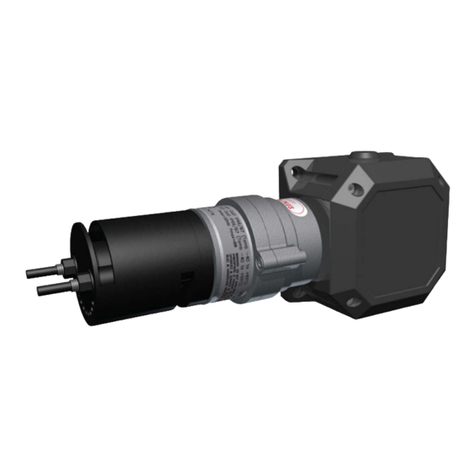
Consilium
Consilium Salwico GD True IR GS5000 Calibration Instruction
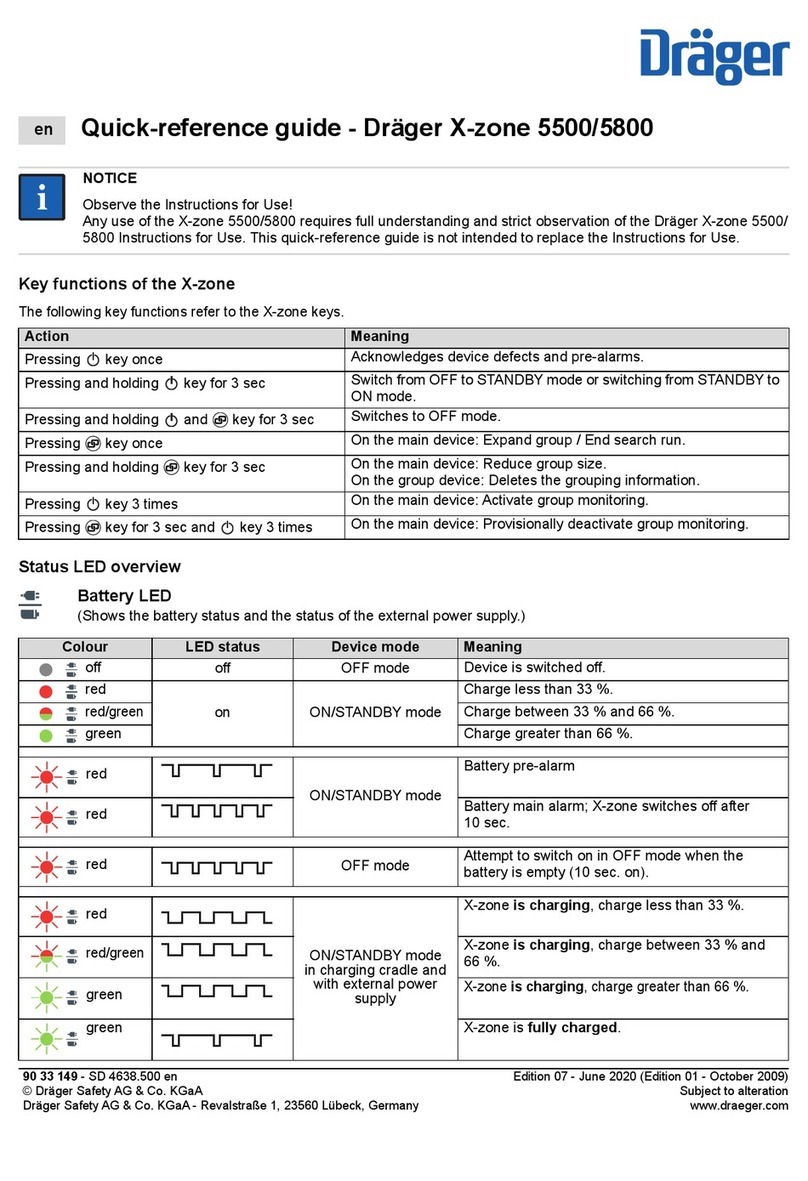
Dräger
Dräger X-zone 5500 Quick reference guide

Crowcon
Crowcon AGM 55 operating instructions
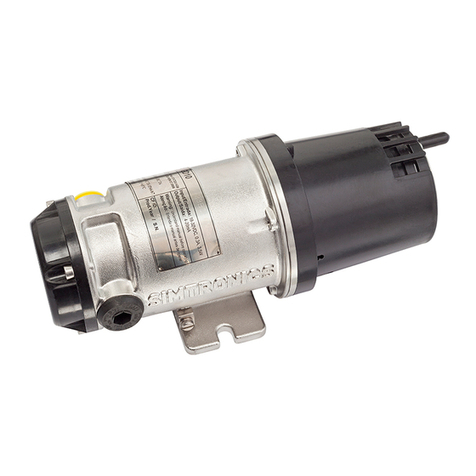
TELEDYNE OLDHAM SIMTRONICS
TELEDYNE OLDHAM SIMTRONICS Everywhereyoulook GD10-P00 operating manual
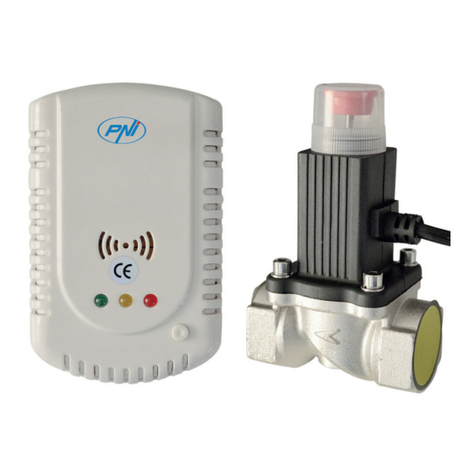
PNI
PNI GD-01 user manual
